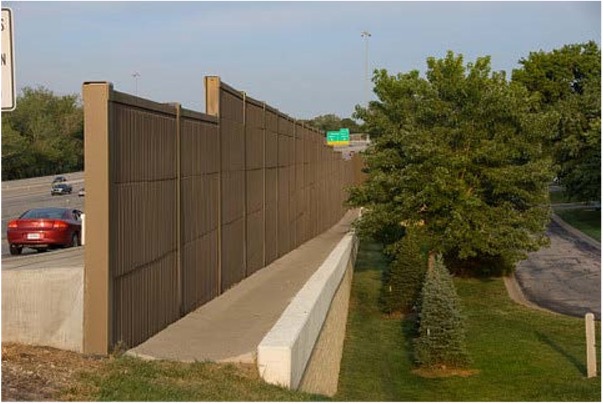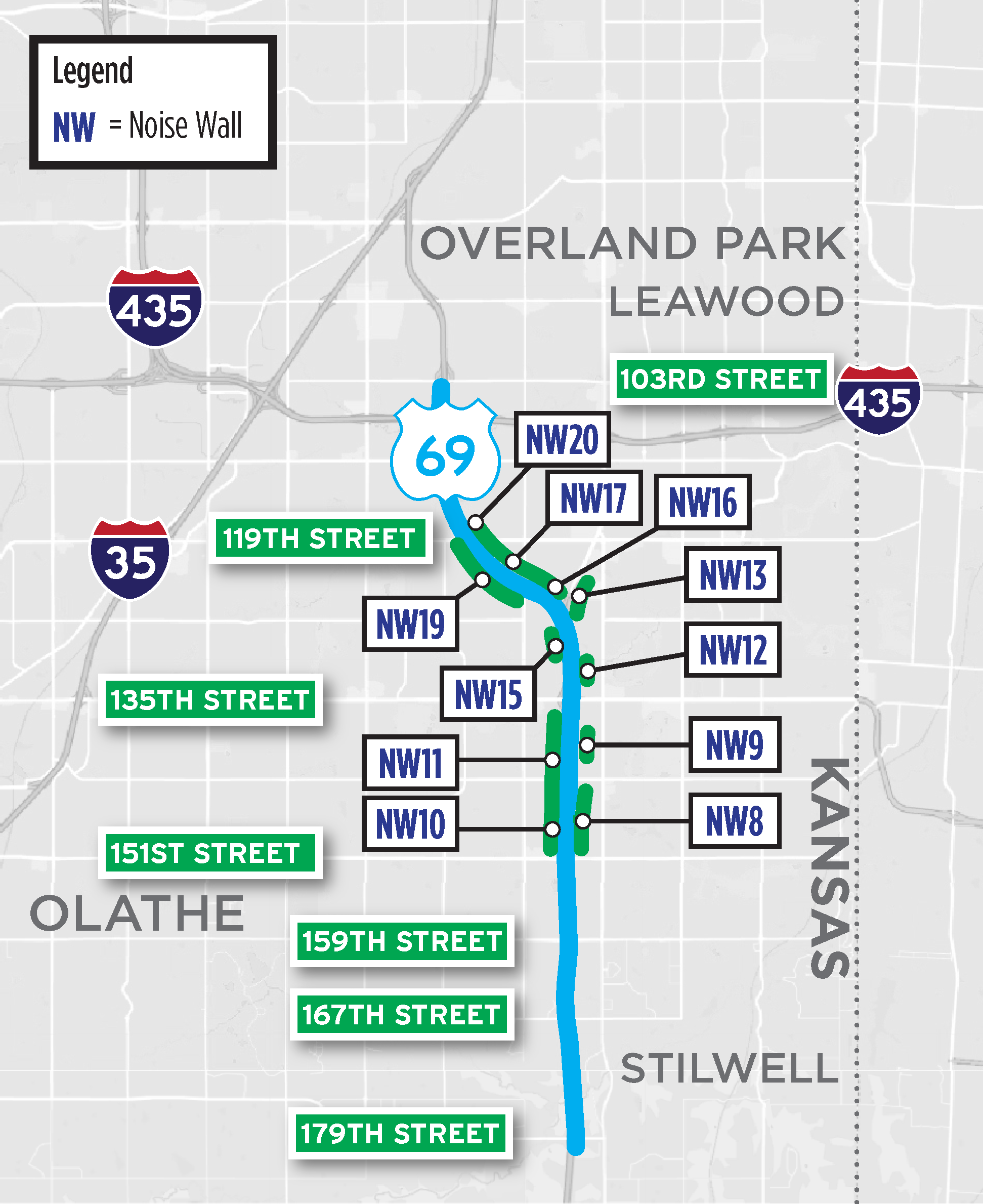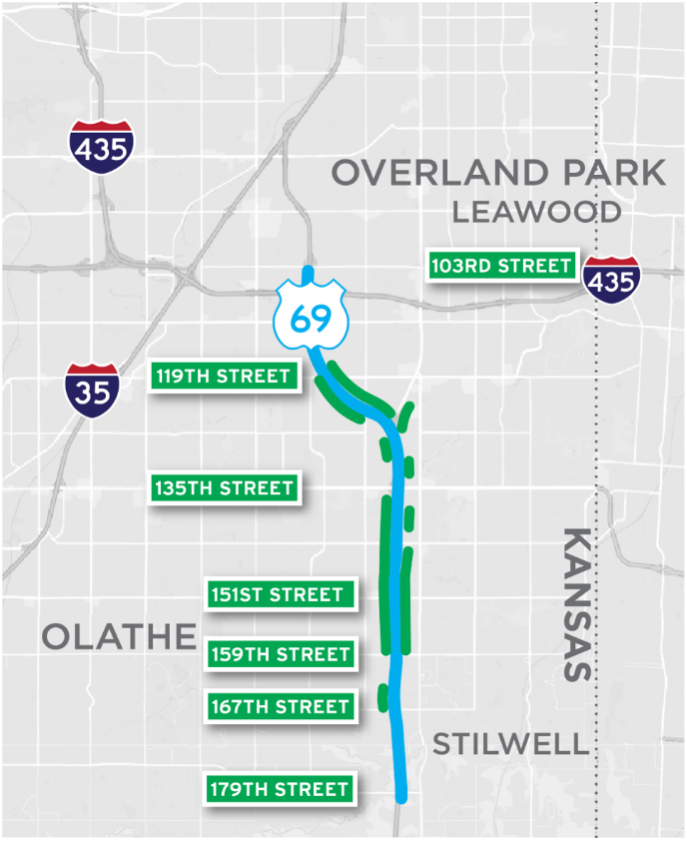When there are significant highway improvements or expansions like those being made as part of 69Express, potential traffic noise impacts are studied during the Project’s Environmental Assessment (EA). This is done to help identify and evaluate a project’s potential impacts on the natural and human-made environments so agencies like the Kansas Department of Transportation (KDOT) can make better decisions about solving transportation issues while minimizing impacts such as noise.

Noise Wall Voting Process Results
KDOT will build all 11 noise walls that were proposed along U.S. 69 as part of the 69Express Project. Noise walls will be constructed in locations just north of 119th Street to 151st Street, as noted on the map. The selected areas are locations that may experience traffic noise at or above the state’s 66 dB threshold and for which a noise wall would reduce roadway noise by at least 5 dB, a perceptible level.
KDOT’s Noise Policy requires that community support is necessary for the walls to be constructed. To proceed to construction, each proposed wall needed 70% of the votes received to be favorable. Final vote results exceeded that requirement.
The results from the 69Express Noise Study were shared in a series of online Zoom meetings. KDOT hosted four virtual meetings to share location-specific findings from its 69Express Noise Study. Each meeting focused on the specific wall numbers and locations along the corridor as shown at right.
About 1,500 people were specifically invited to attend these meetings. These people own or reside at properties along U.S. 69 between just north of 119th and 151st Streets that have been identified by the 69Express Noise Study as a Benefitted Receptor – a location that may experience certain noise volumes and may benefit directly by a specific amount from construction of a noise wall.
Benefitted Receptors only were eligible to vote on whether KDOT should proceed with building the noise wall at their locations. Each proposed wall received at least 70% of votes in favor of building the wall as part of the upcoming U.S. 69 Construction Project; therefore all walls will be constructed.

Benefitted Receptors Map
Use your computer’s cursor and the zoom in/zoom out tool in the upper left-hand corner of this map to find out the noise status of your U.S. 69 corridor property as determined by the 69Express Noise Study.
Dots on the map show specific locations where noise levels were modeled to determine whether a location would meet federal and state standards for being considered a Benefitted Receptor, which is a location where:
- Noise levels are projected to be above an average of 66 dBA during the future loudest hour after the U.S. 69 improvements are made and
- A noise wall would provide at least a 5 dBA reduction in noise.
Based on that modeling:
![]() Green dots mark locations unlikely to have noise levels above an average of 66 dBA during the future loudest hour and/or noise walls are not predicted to provide at least a 5 dBA noise reduction.
Green dots mark locations unlikely to have noise levels above an average of 66 dBA during the future loudest hour and/or noise walls are not predicted to provide at least a 5 dBA noise reduction.
![]() Green dots with yellow circles mark locations unlikely to have noise levels above an average of 66 dBA during the future loudest hour, but where noise walls are predicted to reduce noise at least 5 dBA.
Green dots with yellow circles mark locations unlikely to have noise levels above an average of 66 dBA during the future loudest hour, but where noise walls are predicted to reduce noise at least 5 dBA.
![]()
![]()
![]()
![]()
![]()
![]()
![]()
![]()
![]()
![]()
![]()
Any location marked with a green with yellow dot or red with yellow dot is considered a Benefitted Receptor for the purpose of voting on whether to build a proposed noise wall at the affected location.


How Noise Studies Are Conducted
Conducting a noise evaluation involves taking field measurements of current sound levels. Those results are then run through a detailed software model to determine if:
- Current noise levels are above 66 dB or
- The project results in a predicted increase in noise levels of more than 10 dB.
For 69Express, KDOT also decided that the noise evaluation should use criteria consistent with previous studies done in areas adjacent to the U.S. 69 corridor.
Using these criteria, the Project Team recommended noise walls be built in 14 locations — 11 with the near-term construction project (103rd to 151st Streets) and three to be built during future construction phases.
